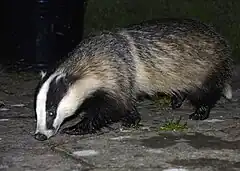| Melinae | |||
| Bonaparte, 1838[1] | |||
 Przedstawiciel podrodziny – borsuk europejski (Meles meles) | |||
| Systematyka | |||
| Domena | |||
|---|---|---|---|
| Królestwo | |||
| Typ | |||
| Podtyp | |||
| Gromada | |||
| Podgromada | |||
| Rząd | |||
| Podrząd | |||
| Infrarząd | |||
| Nadrodzina | |||
| Rodzina | |||
| Podrodzina |
Melinae | ||
| Typ nomenklatoryczny | |||
|
Meles Brisson, 1762 | |||
| Synonimy | |||
|
| |||
| Rodzaje | |||
| |||
Melinae – podrodzina ssaków z rodziny łasicowatych (Mustelidae).
Zasięg występowania
Podział systematyczny
Do podrodziny należą następujące występujące współcześnie rodzaje[9][8][10]:
Opisano również rodzaje wymarłe[11]:
Uwagi
- ↑ Typ nomenklatoryczny: Taxus É. Geoffroy Saint-Hilaire & F. Cuvier, 1795 (= Meles Brisson, 1762).
Przypisy
- 1 2 Ch.L. Bonaparte. Synopsis Vertebratorum Systematis. „Nuovi annali delle scienze naturali”. 2, s. 110, 1838. (łac.).
- ↑ J.G. Fisher von Waldheim. De systemate Mammalium. „Mémoires de la Société impériale des naturalistes de Moscou”. 5, s. 372, 1817. (łac.).
- ↑ J.E. Gray. An Outline of an Attempt at the Disposition of Mammalia into Tribes and Families, with a List of the Genera apparently appertaining to each Tribe. „Annals of Philosophy”. New Series. 10, s. 339, 1825. (ang.).
- ↑ H. Burmeister: Verzeichnis der im zoologischen Museum der Universität Halle-Wittenberg aufgestellten Säugethiere, Vögel und Amphibien. Halle: W. Plötz, 1850, s. 13. (niem.).
- ↑ J.E. Gray: Catalogue of carnivorous, pachydermatous, and edentate Mammalia in the British museum. London: The Trustees, 1869, s. 120. (ang.).
- ↑ H. Winge: Jordfundne og nulevende rovdyr (Carnivora) fra Lagoa Santa, Minas Geraes, Brasilien: med udsigt over pungdyrenes slægtskab. Kjøbenhavn: F. Dreyer, 1895, s. 47. (szw.).
- ↑ G. Petter. Origine, phylogénie et systématique des blaireaux. „Mammalia”. 35 (4), s. 596, 1971. DOI: 10.1515/mamm.1971.35.4.567. (ang.).
- 1 2 C.J. Burgin, D.E. Wilson, R.A. Mittermeier, A.B. Rylands, T.E. Lacher & W. Sechrest: Illustrated Checklist of the Mammals of the World. Cz. 2: Eulipotyphla to Carnivora. Barcelona: Lynx Edicions, 2020, s. 450. ISBN 978-84-16728-35-0. (ang.).
- ↑ N. Upham, C. Burgin, J. Widness, M. Becker, C. Parker, S. Liphardt, I. Rochon & D. Huckaby: Treeview of Mammalian Taxonomy Hierarchy. [w:] ASM Mammal Diversity Database (Version 1.11) [on-line]. American Society of Mammalogists. [dostęp 2023-12-20]. (ang.).
- ↑ Nazwy zwyczajowe za: W. Cichocki, A. Ważna, J. Cichocki, E. Rajska-Jurgiel, A. Jasiński & W. Bogdanowicz: Polskie nazewnictwo ssaków świata. Warszawa: Muzeum i Instytut Zoologii PAN, 2015, s. 155–156, 158. ISBN 978-83-88147-15-9. (pol. • ang.).
- ↑ J.S. Zijlstra, Melinae Bonaparte, 1838, Hesperomys project (Version 23.8.1), DOI: 10.5281/zenodo.7654755 [dostęp 2023-12-20] (ang.).
- ↑ J. Stach. Arctomeles pliocaenicus, nowy rodzaj i gatunek z podrodziny borsukowatych. „Acta Geologica Polonica”. 2 (1–2), s. 129, 1951. (pol.).
- ↑ P.R. Bjork. The Carnivora of the Hagerman Local Fauna (Late Pliocene) of southwestern Idaho. „Transactions of the American Philosophical Society”. New series. 60 (7), s. 19, 1970. DOI: 10.2307/1006119. (ang.).
- ↑ O. Zdansky. Jungtertiäre carnivoren Chinas. „Palaeontologia Sinica”. Series C. 2 (1), s. 55, 1924. (niem.).
- ↑ U.B. Deshmukh & A. Valenciano. Neoyunnanotherium nom. nov., a replacement name for the genus Yunnanotherium Qi, 2014 (Carnivora, Mephitidae) non Han, 1986 (Tragulidae). „Zootaxa”. 5222 (3), s. 298–300, 2022. DOI: 10.11646/zootaxa.5222.3.7. (ang.).
This article is issued from Wikipedia. The text is licensed under Creative Commons - Attribution - Sharealike. Additional terms may apply for the media files.